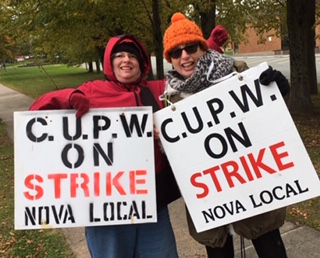KJIPUKTUK (Halifax) – A bitterly cold wind swept down Almon Street in Halifax today when I arrived at the picket line at Halifax’s main postal plant. But the 40 or so picketers seemed to take it in stride; almost all were wearing navy blue Canada Post gore-tex jackets or parkas with the post office logo on the sleeves and gloves. The Canadian Union of Postal Workers (CUPW) strike signs were twisting around the picketers’ necks, and it was pretty hard to hold signs up for the motorists driving by.

The café across the road was doing a brisk business in take-out double-doubles. But there were no deck chairs or folding tables – this is a serious picket line which blocked anything from going in or out of the plant.
I spoke with one woman, a truck driver, who had worked at Canada Post for 28 years. “It’s a long time,” she said. “I once was a letter carrier, but I couldn’t do the work any longer – it’s such a hard job. And I hear we just got the contract for Toys are Us!” She groaned.
With the volume of boxes and packages from online shopping growing by the month, letter carriers are carrying more heavy and awkward parcels than ever before. It is very hard on carriers’ backs. They are also carrying fat, heavy, glossy catalogues from retailers such as IKEA and Canadian Tire, as well as flyers and letters.
“They want to contract out the work, not have full-time well paid jobs,” one CUPW member told me. “They need more of us because of the huge volume of boxes and packages, but Canada Post is not hiring permanent full time workers.”
She told me once upon a time, letter carriers started work at 6.30 am with sorting their mail and were finished their deliveries by 3 pm. Not anymore. While there is an early shift, more and more CUPW members are starting as late as noon – which means they have to deliver mail – sometimes to up to 2000 addresses daily — till about 8 pm. In fall and winter, they are walking alone, in the dark, often on treacherous streets to deliver the mail.
“The number of injured members is off the scale,” another CUPW member told me, “We’re only human but management is inhumane. “
Another important issue is the rural and suburban mail carriers, or RSMCs. For years the 8,000 mainly female rural carriers across the country have been paid about 25% less than their counterparts in cities and suburbs. In a pay equity settlement decided exactly one month ago today, the arbitrator ruled that there should be pay parity and equal benefits between the rural and the urban/suburban letter carriers. Most of the urban/suburban carriers are male. That means a pay hike for the rural carriers from $19.73 to $25.95 an hour retroactive to 2016.
While on paper, nearly $26 an hour looks good, and it works out to over $50,000 a year, consider this:
In 2016, according to the Canadian Centre for Policy Alternatives Nova Scotia, the “living wage” in Halifax was set at $19.17 an hour; in Antigonish it was $17.30 an hour. Toronto’s living wage was $18.52 an hour. In 2018, the living wage in Vancouver rose to $20.91 an hour. The Living Wage is the amount needed for a family of four with two parents working full-time at this hourly rate to pay for necessities, support the healthy development of their children, escape severe financial stress and participate in the social, civic and cultural lives of their communities.
How many two-parent families actually earn two Living Wage salaries? How many single parents earn even one Living Wage? Instead, across the country, minimum wage is set very low. Employers often pay wages based on their province’s minimum wage. That means hundreds of thousands of Canadians earn a couple of dollars more than $12.65 an hour BC, $14.00 an hour in Ontario, or $11 an hour in Nova Scotia. Nova Scotia has the lowest minimum wage in Canada.
The fact that CUPW fights for just wages, better benefits, pay equity, safe work and against bullying in the workplace helps us all.
Judy Haiven is founding member of Equity Watch. She retired from teaching Industrial Relations at the Sobey School of Business at Saint Mary’s University.
See also: Letter from a postal worker: A better Canada Post for everyone
If you can, please support the Nova Scotia Advocate so that it can continue to cover the Canada Post strike and issues such as poverty, racism, exclusion, workers’ rights and the environment in Nova Scotia. A paywall is not an option, since it would exclude many readers who don’t have any disposable income at all. We rely entirely on one-time donations and a tiny but mighty group of dedicated monthly sustainers.
Subscribe to the Nova Scotia Advocate weekly digest and never miss an article again.



